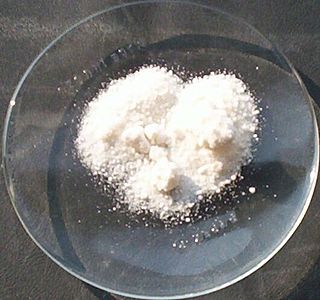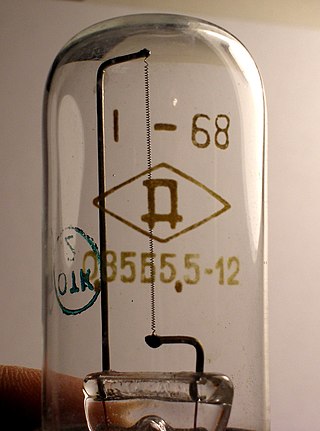Related Research Articles

Lithium aluminium hydride, commonly abbreviated to LAH, is an inorganic compound with the chemical formula Li[AlH4] or LiAlH4. It is a white solid, discovered by Finholt, Bond and Schlesinger in 1947. This compound is used as a reducing agent in organic synthesis, especially for the reduction of esters, carboxylic acids, and amides. The solid is dangerously reactive toward water, releasing gaseous hydrogen (H2). Some related derivatives have been discussed for hydrogen storage.

Chromium(III) chloride (also called chromic chloride) describes any of several chemical compounds with the formula CrCl3 · xH2O, where x can be 0, 5, and 6. The anhydrous compound with the formula CrCl3 is a violet solid. The most common form of the trichloride is the dark green hexahydrate, CrCl3 · 6 H2O. Chromium chlorides find use as catalysts and as precursors to dyes for wool.

Caesium chloride or cesium chloride is the inorganic compound with the formula CsCl. This colorless salt is an important source of caesium ions in a variety of niche applications. Its crystal structure forms a major structural type where each caesium ion is coordinated by 8 chloride ions. Caesium chloride dissolves in water. CsCl changes to NaCl structure on heating. Caesium chloride occurs naturally as impurities in carnallite, sylvite and kainite. Less than 20 tonnes of CsCl is produced annually worldwide, mostly from a caesium-bearing mineral pollucite.

Lithium hydride is an inorganic compound with the formula LiH. This alkali metal hydride is a colorless solid, although commercial samples are grey. Characteristic of a salt-like (ionic) hydride, it has a high melting point, and it is not soluble but reactive with all protic organic solvents. It is soluble and nonreactive with certain molten salts such as lithium fluoride, lithium borohydride, and sodium hydride. With a molar mass of 7.95 g/mol, it is the lightest ionic compound.

Indium(III) chloride is the chemical compound with the formula InCl3. This salt is a white, flaky solid with applications in organic synthesis as a Lewis acid. It is also the most available soluble derivative of indium. This is one of three known indium chlorides.
Magnesium compounds are compounds formed by the element magnesium (Mg). These compounds are important to industry and biology, including magnesium carbonate, magnesium chloride, magnesium citrate, magnesium hydroxide, magnesium oxide, magnesium sulfate, and magnesium sulfate heptahydrate.

Dicobalt octacarbonyl is an organocobalt compound with composition Co2(CO)8. This metal carbonyl is used as a reagent and catalyst in organometallic chemistry and organic synthesis, and is central to much known organocobalt chemistry. It is the parent member of a family of hydroformylation catalysts. Each molecule consists of two cobalt atoms bound to eight carbon monoxide ligands, although multiple structural isomers are known. Some of the carbonyl ligands are labile.
Cobalt(II) cyanide is the inorganic compound with the formula Co(CN)2. It is coordination polymer that has attracted intermittent attention over many years in the area of inorganic synthesis and homogeneous catalysis.

Vanadium(V) fluoride is the inorganic compound with the chemical formula VF5. It is a colorless volatile liquid. It is a highly reactive compound, as indicated by its ability to fluorinate organic substances.
Polysilicon hydrides are polymers containing only silicon and hydrogen. They have the formula where 0.2 ≤ n ≤ 2.5 and x is the number of monomer units. The polysilicon hydrides are generally colorless or pale-yellow/ocher powders that are easily hydrolyzed and ignite readily in air. The surfaces of silicon prepared by MOCVD using silane (SiH4) consist of a polysilicon hydride.

Disulfur difluoride is a halide of sulfur, with the chemical formula S2F2.

Magnesium iron hexahydride is an inorganic compound with the formula Mg2FeH6. It is a green diamagnetic solid that is stable in dry air. The material is prepared by heating a mixture of powdered magnesium and iron under high pressures of hydrogen:
Rhenium(VII) sulfide is a chemical compound with the formula Re2S7. It can be produced through the reaction of ReO4− and H2S in 4N HCl.
Iron(II) hydride, systematically named iron dihydride and poly(dihydridoiron) is solid inorganic compound with the chemical formula (FeH
2)
n (also written ([FeH
2])n or FeH
2). ). It is kinetically unstable at ambient temperature, and as such, little is known about its bulk properties. However, it is known as a black, amorphous powder, which was synthesised for the first time in 2014.

Iron–hydrogen alloy, also known as iron hydride, is an alloy of iron and hydrogen and other elements. Because of its lability when removed from a hydrogen atmosphere, it has no uses as a structural material.
Yttrium hydride is a compound of hydrogen and yttrium. It is considered to be a part of the class of rare-earth metal hydrides. It exists in several forms, the most common being a metallic compound with formula YH2. YH2 has a face-centred cubic structure, and is a metallic compound. Under great pressure, extra hydrogen can combine to yield an insulator with a hexagonal structure, with a formula close to YH3. Hexagonal YH3 has a band gap of 2.6 eV. Under pressure of 12 GPa YH3 transforms to an intermediate state, and when the pressure increases to 22 GPa another metallic face-centred cubic phase is formed.
Iridium trihydride (IrH3) is a chemical compound of iridium and hydrogen that can be formed under high pressure. The crystalline form has a distorted simple cubic structure. The hydrogen atoms are on the centre of the faces of the crystal cell cube, and Iridium is at the centre. It forms at over 55 GPa.
Neodymium(III) hydride is an inorganic compound composed of neodymium and hydrogen with a chemical formula NdH3. In this compound, the neodymium atom is in the +3 oxidation state and the hydrogen atoms are -1. It is highly reactive.
Cobalt compounds are chemical compounds formed by cobalt with other elements. In the compound, the most stable oxidation state of cobalt is the +2 oxidation state, and in the presence of specific ligands, there are also stable compounds with +3 valence. In addition, there are cobalt compounds in high oxidation states +4, +5 and low oxidation states -1, 0, +1.
Neptunium compounds are compounds containg the element neptunium (Np). Neptunium has five ionic oxidation states ranging from +3 to +7 when forming chemical compounds, which can be simultaneously observed in solutions. It is the heaviest actinide that can lose all its valence electrons in a stable compound. The most stable state in solution is +5, but the valence +4 is preferred in solid neptunium compounds. Neptunium metal is very reactive. Ions of neptunium are prone to hydrolysis and formation of coordination compounds.
References
- ↑ Химическая энциклопедия. Vol. 2. М.: Советская энциклопедия. Редкол.: Кнунянц И.Л. и др. 1990. ISBN 5-85270-035-5.
- ↑ Рипан Р., Четяну И. (1972). Неорганическая химия. Химия металлов. Vol. 2. М.: Мир.
- ↑ Wang, Mengnan; Binns, Jack; Donnelly, Mary-Ellen; Peña-Alvarez, Miriam; Dalladay-Simpson, Philip; Howie, Ross T. (13 April 2018). "High pressure synthesis and stability of cobalt hydrides" (PDF). The Journal of Chemical Physics. 148 (14): 144310. Bibcode:2018JChPh.148n4310W. doi:10.1063/1.5026535. hdl: 20.500.11820/2b963cd7-cf80-42a7-8f7e-31518de1d934 . ISSN 0021-9606. PMID 29655356.